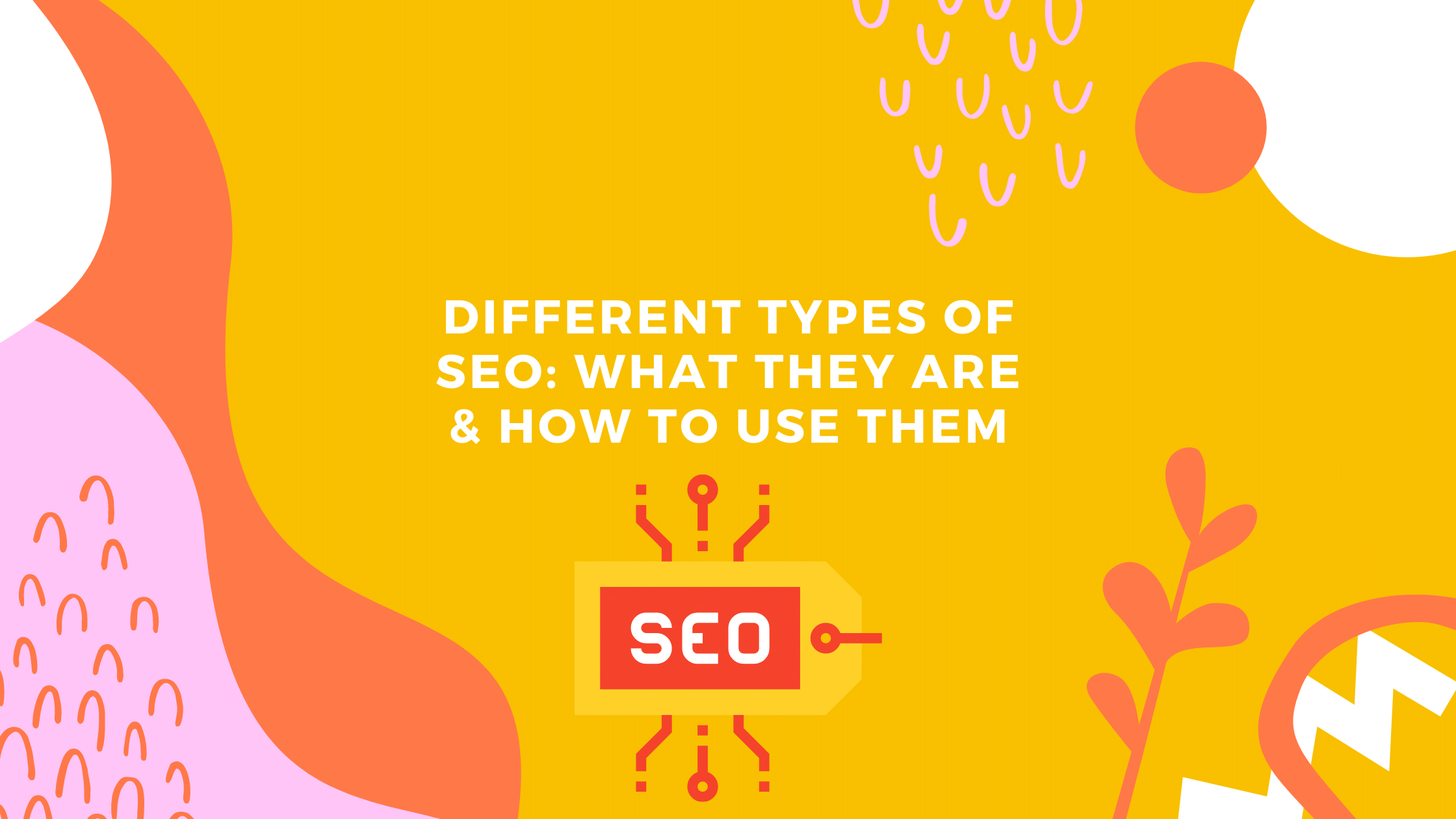Before we begin looking at the different types of SEO let us first get to know what SEO is. SEO stands for Search Engine Optimization and it is the process of improving your website to increase your rankings in search engine results for keywords related to your business. The main goal of SEO is to increase organic traffic from Google or other search engines by improving your site’s position in the SERPS (Search Engine Results Page) for relevant keywords or search terms. If you manage to get the top spot on Google for example you’ll be generating a lot of traffic to your website, therefore, making sales for free.
Watch the video below from Simplilearn on “What is SEO and How Does it Work”
In this article, we will learn the different types of SEO and what SEO techniques are used for each type.
Here are different types of SEO:
- On-Page SEO
- Off-Page SEO
- Technical SEO
- Local SEO
- Enterprise SEO
- eCommerce SEO
- Mobile SEO
- Negative SEO
- Youtube SEO
If you are searching for the different types of SEO used by site owners to generate organic traffic to their websites then keep on reading.
What are the Types of SEO?
Let’s now look at the different types of SEO strategies in detail so you can know which type to use to grow your organic search traffic.
1. What is On-page SEO?
On-page SEO is the practice of optimizing individual web pages in order to rank higher and earn more visitors from search engines. On-page refers to all elements of a page that can be controlled by the website owner, including the title, meta data, images, and content.
The goal of on-page SEO is to make it as easy as possible for search engine algorithms to understand what a particular page is about. This can be done by adding relevant keywords and phrases to titles, meta data, and within the body of the content itself.
It’s also important to ensure that pages are properly formatted and easy to read. This includes using clear headings and subheadings, formatting text with correct spelling and grammar, and using images to break up large blocks of text.
On-page SEO is just one part of a successful SEO strategy. It’s important to also focus on off-page SEO factors such as link building and social media engagement. However, on-page optimization is a good place to start for any website looking to improve its search engine rankings.
How important is On-Page SEO?
On-page SEO is the practice of optimizing your website’s content and structure for the purpose of ranking higher in search engine results pages (SERPs). If you want to rank high in Google, you need to focus on your on-page SEO.
There are many factors that go into determining how well your website will rank in search engines. Some of these factors include your website’s content, its structure, its metadata, and its backlinks. But one of the most important factors is your website’s on-page SEO.
On-page SEO is important because it helps you control how your website appears in search engine results pages. If you optimize your website for certain keywords, you can increase the chances that your website will rank higher in SERPs for those keywords.
One of the best ways to improve your on-page SEO is by using keywords. You should include your target keywords in your website’s title tag, its meta description, and its header tags. You should also use them throughout your website’s content.
But optimizing your website for keywords is just one part of on-page SEO. You also need to make sure that your website’s content is high quality and that it provides value to users. If you publish low-quality content, you will not rank high in search engines.
So, is on-page SEO important? The answer is yes – it’s one of the most important aspects of SEO. If you want to rank high in Google, you need to focus on your on-page SEO. And the best way to improve your on-page SEO is by using keywords.
On-Page SEO Techniques

here are quite a number of on-page SEO techniques to look at. Spending time to optimize each of these factors will help improve your rankings in Google search results. Below are some of the most used on-page SEO techniques;
- URL Optimization – Include your primary keyword in your URL to give people an idea of your page’s topic and use shorter URLs.
- Optimize the Title Tags – Use specific keywords in the title tag of each page so that search engine crawlers can understand your website.
- Meta Descriptions – Include a meta description on each page, your page’s summary is what is called a meta description and appears in SERPs. It helps users learn about your page.
- Heading Tags – Use heading tags in your content to break it up and make it more readable for users. You can also add your primary or related keywords to tags. There are H1 heading tags, H2, H3, H4, and so on.
- Alt tags – Include alt tags in your multimedia content since search engines can’t see multimedia content.
- Keywords – Research and come up with keywords for each page or post on your website.
- Content – Publish high-quality content
- Internal Links – Internal linking is important as it helps crawlers explore your site and discover new content.
- Mobile-friendliness – Your website should be mobile friendly as more than 50% of internet traffic is from mobile devices. If you don’t this can affect your search engine rankings.
On-page SEO is critical if you want to improve your site’s chances of showing up in search engine results.
2. What is Off-Page SEO?
Off-page SEO is the process of improving the ranking of a website on search engines by increasing its visibility and influence on other websites. It is a critical element of any successful SEO strategy and involves a variety of techniques, including link building, social media marketing, and content marketing.
The goal of off-page SEO is to create backlinks from high-quality websites that point to your site. The more links you have from authoritative websites, the higher your site will rank in search engine results pages (SERPs). In addition, off-page SEO can help you build a strong online presence and increase brand awareness.
There are a number of different off-page SEO techniques that you can use to improve your website’s ranking. Here are a few of the most popular:
1. Link building
Link building is one of the most important off-page SEO techniques. It involves acquiring links from high-quality websites that point to your site. The more links you have from authoritative websites, the higher your site will rank in SERPs.
There are a number of different ways to build links, including guest posting, blog commenting, and social media marketing. Guest posting is one of the most effective methods, as it allows you to reach a new audience and generate high-quality backlinks.
2. Social media marketing
Social media is an important part of off-page SEO. By creating social media profiles for your website and sharing valuable content, you can increase your website’s visibility and reach a new audience. In addition, social media platforms like Twitter and Facebook can be used to build links to your site.
3. Content marketing
Content marketing is another important off-page SEO technique. By creating high-quality content that is relevant to your target audience, you can attract visitors to your website and improve your site’s ranking in SERPs. In addition, content marketing can help you build a strong online presence and increase brand awareness.
Off-page SEO is an essential part of any successful SEO strategy. By using a variety of techniques, you can improve your website’s ranking in SERPs, build a strong online presence, and increase brand awareness.
If you’re looking to improve your website’s SEO, be sure to implement off-page SEO techniques. These techniques will help you increase your website’s visibility and reach a new audience. For more information, contact an SEO company today.
Other most used techniques to improve off-page SEO:
- Guest Blogging – Guest blogging helps you build both your reputation and links, insert a link that links back to your own site in the post before you upload it. Also, insert a link in your bio.
- Build relationships and trust on platforms like Quora and Reddit. Answer questions to build links.
- Influencer Marketing – Reach out to online influencers. If your brand is endorsed by an online influencer you’ll boost your audience’s trust in your products or services.
- Social Bookmarking – Submit your content to websites like StumbleUpon.
- Youtube Videos – Create your content into videos and upload them on youtube with the right combination of title tag and description, link to your website as well.
- Blog Commenting – Comment on blogs related to your niche and let the people know about you and your blog.
- Directory Submission – Submit your blog to popular online directories
- Article Sharing – Share your articles on popular article sharing websites
- Broken link building – Find broken links on other sites and create similar content then ask owners to replace the links with yours.
- Business Reviews – Try making reviews on popular review sites and put your name and URL.
- Competitor research – Use tools like Ubersuggest to find out the backlink profile of your competitors. Check where they are getting links and try to get them as well.
Off-page SEO will increase your website’s popularity online, off-page SEO techniques will therefore improve your website position in search engine results.
3. What is Technical SEO?
Technical SEO is the practice of optimizing a website for technical search engine crawlers. This includes improving site speed, indexing, and architecture. Technical SEO is especially important for eCommerce websites and websites with a lot of content.
Some common techniques used in Technical SEO include:
- Ensuring that all pages are indexable by search engine crawlers
- Optimizing page titles and meta descriptions
- Improving site speed and load time
- Fixing broken links and 404 errors
- Configuring hreflang tags correctly
- Optimizing images for SEO
- Creating an XML sitemap and submitting it to Google Search Console
Focusing on Technical SEO can help improve your website’s visibility in search engine results pages, as well as increase traffic and conversions. If you’re not sure where to start, contact a Technical SEO specialist for help.
Other best practices to consider to achieve Technical SEO:
- Optimize the Robots.txt file – The Robots.txt instructs search engine crawlers which part of the website should be crawled or not. So make sure the file doesn’t block parts of your website you want to be crawled.
- Create an XML sitemap – XML sitemap is a list of all pages of your website. It helps search engines in crawling your website it’s like a roadmap of your site.
- Mobile Optimization – Test your website if it is mobile-friendly. From 2015 onwards mobile-friendliness has been a huge Google ranking factor. You can use Google’s mobile-friendly testing tools.
- Migrate to HTTPS – Install an SSL certificate on your website. HTTPS is a Google ranking factor
- Duplicate Content – Find and fix duplicate content issues
- Preferred Domain version – Set the domain version you prefer www or the non-www
- Search for any errors by using website crawler tools.
- Website structure and navigation – Navigation is critical to search engines
- Crawl your website using crawl tools and check for any crawl errors
- Disavow low-quality “spammy” backlinks
- Submit your website to Google Search Console – This will help in indexing your website faster
Watch the video below from Ahrefs on “Technical SEO Best Practices for Beginners”
Technical SEO has quite a number of checks and settings you need to work on so that search engines can easily crawl and index your website. To make things much easier you can use tools like Semrush to find and fix technical problems.
4. What is Local SEO?
Local SEO is a branch of SEO that is designed to help businesses rank higher in search engine results pages for queries that are specific to their location. For example, if you search for “plumbers near me” on Google, the businesses that appear in the results are likely using local SEO tactics to improve their ranking.
There are a number of things businesses can do to improve their local SEO ranking, including creating and optimizing listings on Google My Business, developing strong backlinks from local websites, and publishing high-quality content that is relevant to their target audience.
Local SEO can be a great way to help businesses attract more customers from their local area.
How is Local SEO implemented?
- Create content that is local
- Find local keywords that are relevant to your business
- Optimize your free Google My Business (GMB) profile
- Optimize online directories – Add your site to local online directories
- Make sure your business location shows on Google Maps
- Ask for online customer reviews for your website and business
- Use Social Media – Share your Google My Business page
- Make sure your site is mobile-friendly
If you have a local business, local SEO will help your potential customers easily find you when they search online.
5. What is Enterprise SEO?
In its most basic form, enterprise SEO is the application of search engine optimization techniques to a company’s website on a larger scale. While small businesses may only need to focus on optimizing their website for local search results, enterprise-level businesses must take a more holistic and strategic approach to SEO in order to achieve better visibility among global search engines.
There are several key factors that set enterprise SEO apart from smaller-scale SEO initiatives. First and foremost, enterprise SEO requires a greater investment of time and resources in order to be successful. In addition, an enterprise-level business must have a more sophisticated understanding of how search engines work and how to optimize their website accordingly. Finally, an effective enterprise SEO strategy must also take into account the competitive landscape and how the business’s website stacks up against its rivals.
If you’re looking to improve your website’s visibility among global search engines, then enterprise SEO is the right solution for you. By investing the time and resources necessary to implement a successful SEO strategy, you can ensure that your website will rank high among relevant search results and attract more visitors from around the world.
Some of the most used Enterprise SEO tactics:
- Targeting competitive short-tail keywords
- Optimizing the website’s Architecture
- Optimizing content for featured snippets
- Conducting Competitive Research – tracking what your competitors are up to
- Writing high-quality SEO optimized content
- Conducting Technical SEO
- Link building
- Adopting voice search
Enterprise SEO is all about optimizing and ranking enterprise-level sites with thousands or even millions of pages. This type of SEO has the same strategies as standard SEO, however, the major difference is that this type is done at a much larger scale.
6. What is eCommerce SEO?
eCommerce SEO is the process of optimizing a website for the purpose of increasing sales and revenue through online channels. The goal of eCommerce SEO is to improve the visibility of a website in search engine results pages (SERPs), driving more traffic and ultimately resulting in more conversions.
There are a variety of techniques that can be used as part of an eCommerce SEO campaign, including on-page optimization, link building, and content marketing. In order to be successful, it is important to understand how each of these tactics can help to improve website visibility and drive traffic.
Some of the widely-used eCommerce SEO tactics;
- Competitor SEO Audit – Finding out what the competition is doing right and copying from them.
- Keyword Research – Optimizing the website with relevant keywords for example in the product description, headline, meta description, image alternate attributes, and so on. This is done after thorough keyword research.
- On-Page SEO for Product pages – Optimizing meta descriptions, page titles, URLs, images, etc.
- Improving site Architecture – The e-commerce store website should be easy to navigate
- Optimizing page loading speed – Increasing page load speeds in both desktop and mobile versions.
- Building backlinks – The more backlinks the better but the backlinks should be of high quality.
- Optimizing website for mobile users – A number of people are shopping using their mobile phones these days.
- Finding and removing broken links – Broken pages can lead to 404 errors
- eCommerce SEO Tools – Utilizing the right eCommerce SEO tools like Ubersuggest and Ahrefs
Your e-commerce website will rank higher in Google and other search engines If the above strategies are followed. This will result in more product sales.
7. What is Mobile SEO?

Mobile SEO is the practice of optimizing a website for mobile devices. This includes optimizing the website for specific mobile platforms such as Android or iOS, and making sure the website is responsive so it looks good and functions properly on mobile devices.
Mobile SEO is important because more and more people are using their smartphones and tablets to browse the web. In fact, recent studies have shown that more people are now using mobile devices to access the internet than desktop computers. This means that if your website isn’t optimized for mobile devices, you’re missing out on a lot of potential traffic.
That’s why it’s important to make sure your website is optimized for mobile devices. There are a number of things you can do to optimize your website for mobile devices, including optimizing your website for specific mobile platforms and making sure your website is responsive.
In addition, you should also consider using a mobile-friendly design for your website. This is a design that is optimized for mobile devices, and it will make your website look good and function properly on smartphones and tablets.
Finally, you should also use responsive images on your website. This means that the images on your website will resize automatically depending on the screen size of the device being used. This ensures that the images look good and are easy to see on all types of devices.
So, if you’re looking to improve your website’s SEO, be sure to focus on mobile SEO. There are a number of things you can do to optimize your website for mobile devices, and it’s important to do all you can to reach as many potential customers as possible.
Some of the best tactics to consider to achieve Mobile SEO:
- Improving website speed – Tools like Google PageSpeed Insights help in providing information on a website’s load time.
- Implementing a responsive design – This enables your website to adapt to any mobile device regardless of screen size. If you are using WordPress make sure to choose a responsive theme.
- Optimizing Local SEO – for example writing local content
- Using HTML5 instead of Flash for Videos
- Avoid blocking images, CSS, and JavaScript
- Avoid Pop-Ups
- Content on Desktop and Mobile should be the same
- Try implementing Accelerated Mobile Pages (AMP)
- Optimize for voice search
For any online business, these days Mobile SEO should be a priority as mobile-friendliness is one of the Google ranking factors and mobile users have increased tremendously.
8. What is Negative SEO
Negative SEO is the practice of using black hat techniques to harm or damage the search engine ranking of a competitor. This can be done through methods such as spamming, hacking, and social engineering. Negative SEO can also involve creating fake web pages and links to redirect traffic away from a competitor’s site.
Since it’s relatively easy to do and difficult to detect, negative SEO can be a powerful tool for businesses seeking to gain an edge over their competition. However, it’s important to note that Google has gotten better at detecting and mitigating against negative SEO attacks. As such, it’s becoming increasingly less effective over time.
If you’re concerned that your website may be targeted by a negative SEO attack, there are several things you can do to protect yourself. First, make sure your site is well-protected against hacking and spamming. You can also use Google’s Webmaster Tools to check for any unusual activity on your site. Finally, keep an eye on your website’s search engine ranking and traffic levels, and if you notice any sudden drops, investigate the cause immediately.
Some of the most common negative SEO techniques
- Link farms
- Scraped and duplicate content
- Negative Reviews
- Pogo Sticking
- Hacking a website and injecting spammy links or content
- Utilizing aggressive robots to slow down a website
- Setting up fake social profiles so as to ruin your reputation
Watch the video below from Hennessey Digital “How to Detect and Protect Your Website From Negative SEO”
To avoid negative SEO always make it a habit to monitor your SEO health. For example, monitoring your website’s backlinks is very important so that you can notice an attack before it occurs.
9. What is Youtube SEO?
Youtube SEO is the practice of optimizing videos for search engines. By following a few simple steps, you can make sure your videos are seen by as many people as possible.
The first step is to make sure your videos are properly tagged. Tags are keywords or phrases that describe the content of your video. When people search for videos on YouTube, they’ll be able to see your video if it’s been tagged with the right keywords.
The second step is to create a good title for your video. The title is what people will see when they search for videos on YouTube, so it’s important to choose a title that accurately describes the content of your video.
The third step is to create a good description for your video. The description is what people will see when they click on your video, so it’s important to write a description that accurately describes the content of your video.
The fourth step is to choose the right category for your video. YouTube has a large number of categories to choose from, so make sure you pick the one that best describes the content of your video.
The fifth step is to upload a high-quality video. A good quality video will look better and be more engaging for viewers.
The sixth step is to add a link to your website in the “About” section of your YouTube channel. This will help direct viewers to your website.
The seventh step is to create a custom thumbnail for your video. A good thumbnail will attract attention and encourage people to click on your video.
The final step is to promote your video. Share it with your friends and followers on social media, and embed it on your website.
By following these tips, you can optimize your videos for search engines and increase the chances of them being seen by potential viewers.
Final Thoughts on Different Types of SEO
It’s very important to know the different types of SEO when you’re coming up with your SEO strategies. Make sure you select the type that will work best for your website and bring about the best results.
If you have any questions about different types of SEO? Share your thoughts in the comments below.




